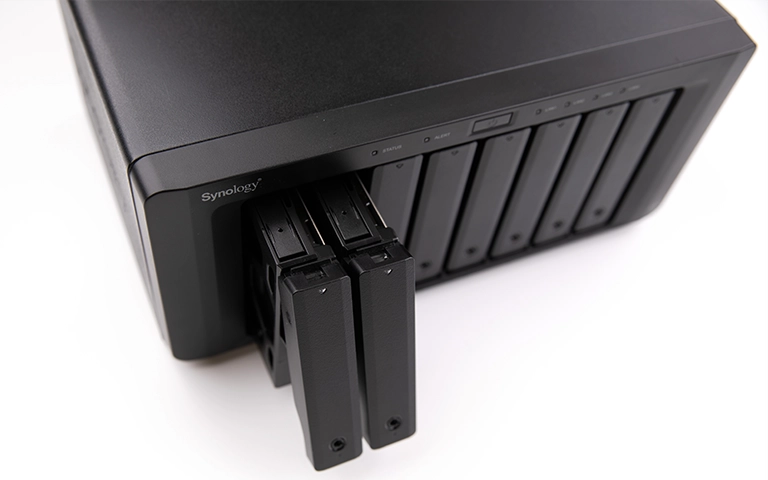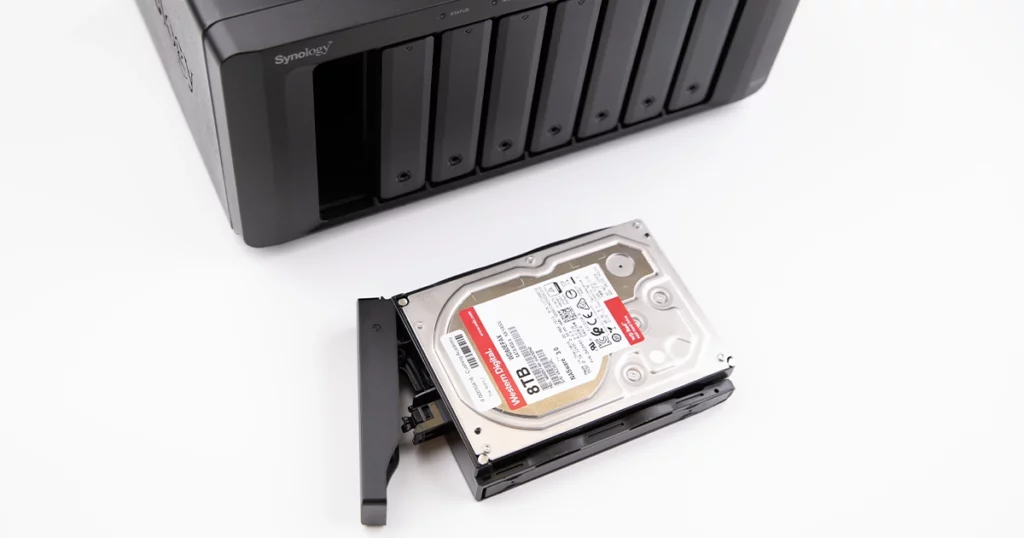A Network Attached Storage (NAS) device is central to storing and sharing data across your network. When it fails, access to critical files can stop without warning, disrupting both personal use and day to day business operations.
A NAS failure does not always result in permanent data loss, but the wrong actions can make recovery far more complex and expensive.
In this guide, you will learn what typically causes NAS failures, how to respond safely, and when to bring in professional support for NAS data recovery.
Learn more about common NAS data loss causes in our article.

Common Causes of NAS Failure
NAS failures can occur for a range of reasons, often involving both hardware and software issues. Understanding these causes helps you act quickly and reduce the risk of irreversible data loss and costly NAS data recovery.
Hardware malfunctions: Power supply faults, damaged controllers, or failing hard drives are among the most frequent causes. Even a single defective drive can degrade or break the entire storage array.
Software or firmware corruption: Failed updates, incorrect settings, or a corrupted operating system can stop your NAS from booting or recognising volumes correctly.
RAID degradation or failed rebuilds: When one or more drives fail in a RAID array, the NAS may enter a degraded state. Attempting a rebuild without proper diagnosis can overwrite critical data and compromise recovery.
Environmental factors: Power surges, overheating, dust, or moisture can physically damage the drives or circuit boards, leading to partial or complete system failure.
For a deeper overview of how these problems develop, read our detailed post on NAS failure and recovery.
Identifying NAS Failure Symptoms
A NAS rarely fails without warning. Spotting the early signs can help you act before a complete loss of data occurs and avoid a more complex NAS data recovery process.
Power or boot issues: The NAS will not power on, restarts repeatedly, or does not respond when you press the power button.
RAID degradation alerts: Flashing or red LEDs, beeping alarms, or dashboard messages such as “Volume Degraded” usually indicate drive or RAID issues that need urgent attention.
Network access problems: Shared folders disappear, mapped drives stop working, or users can no longer connect. In some cases, the NAS may no longer appear on the network at all.
Performance slowdowns: Slow file access, frequent freezes, or connection timeouts can point to disk errors or an impending drive failure.
Unusual sounds: Clicking, grinding, or buzzing noises from the internal drives are strong indicators of mechanical failure.
To understand how different NAS models hold up over time, take a look at our guide on NAS drive failure rates.

Immediate Steps to Take When NAS Fails
When your NAS stops working, every move counts. Stay calm and follow these steps to protect your data and avoid turning a fixable issue into a full NAS data recovery incident.
Keeping a failing NAS powered on can lead to overwriting, further corruption, or even physical damage to the drives. Shut it down as soon as you notice a problem.
Forcing a rebuild can destroy existing data if the RAID configuration, drive order, or number of failed disks is not fully understood.
If you need to remove the drives, mark their order and slot positions first. Mixing them up makes RAID reconstruction and recovery far more difficult.
Take note of warning lights, beeps, and any error messages on the screen or web dashboard. This information helps specialists identify the root cause more quickly.
Avoid DIY repairs or generic software that can write to the disks and make files inaccessible. Specialist NAS data recovery engineers can assess the system safely.
To learn how to deal with degraded RAID arrays in a safer way, review our guide on how to repair degraded RAID.

How Professionals Recover Data from a Failed NAS
Recovering data from a failed NAS involves a detailed, multi stage process that is designed to protect data integrity at every step.
Specialist engineers begin with in depth diagnostics to identify the RAID configuration, drive order, and type of failure. Each hard drive is then opened in an ISO Certified Class 10 Cleanroom so physical issues such as head crashes, motor damage, or PCB faults can be addressed safely.
Once the media is stabilised, technicians create sector by sector images of all drives to preserve every readable bit of data. These images are then used to virtually rebuild the RAID, recreating the original structure without writing anything to the source disks.
After the array has been reconstructed, engineers extract and verify the recovered files, checking for completeness and corruption before transferring them to secure storage.
At RAID Recovery Services, our NAS data recovery specialists apply this process to systems from Synology, QNAP, TerraMaster, Buffalo and other leading vendors, achieving reliable results even in complex multi drive failures.
Learn more about our methods in troubleshooting RAID failure.
Fast turnaround times for business-critical data
Preventing Future NAS Failures
No storage platform is completely immune to failure, but consistent maintenance and smart preventative measures can significantly extend the life of your NAS and reduce the risk of a major NAS data recovery incident.
Begin by monitoring drive health through built in SMART tools or the NAS management dashboard. Replace ageing or unstable drives before they trigger RAID degradation or unplanned downtime.
Keep the firmware and operating system up to date to minimise software related crashes and configuration issues. Always review release notes before applying updates, especially on business critical systems.
Environmental control is just as important. Position your NAS in a cool, dry, well ventilated location and connect it to an uninterruptible power supply to protect against power cuts, spikes, and surges.
Finally, implement regular offsite or cloud backups so that even if the NAS fails unexpectedly, your critical data remains protected and recoverable.
For a complete overview of long term data protection practices, explore our article on data loss prevention.
When To Call RAID Recovery Services
If your NAS has failed and data is no longer accessible, involving specialists is the safest course of action. DIY repairs or software based recovery attempts can overwrite key sectors, corrupt RAID metadata, and turn a recoverable incident into a complex NAS data recovery case. The earlier professionals are involved, the better the chances of a successful outcome.
At RAID Recovery Services, our engineers specialise in recovering data from failed NAS systems, including multi drive RAID arrays, encrypted volumes, virtualised environments, and physically damaged units.
We use advanced imaging technology, secure recovery labs, and detailed diagnostics to restore lost files while keeping risk to an absolute minimum.
Whether your NAS has suffered drive failure, firmware corruption, file system damage, or controller faults, our team can manage the recovery in a controlled and transparent way.
We provide nationwide support, operate on a no data, no fee basis, and maintain a success rate of up to 99 percent across thousands of NAS recovery cases.

Conclusion
A NAS failure can disrupt day to day operations, but with the right response, successful NAS data recovery is often achievable. Powering the system down, avoiding rebuild attempts, and involving specialists early are the most effective steps to protect your data.
At RAID Recovery Services, we manage complex NAS and RAID failures every day with a structured, proven approach.
Whether your device has been affected by hardware damage, RAID corruption, or firmware issues, our engineers focus on restoring access to your critical files in a controlled and secure way.
Our specialists are available 24/7 to review your situation and outline the safest options. Speak with a NAS recovery expert or request a free consultation today.
Trust the experts with proven results
Frequently Asked Questions
What should I do first when my NAS fails?
Power the device off immediately and disconnect it from the network. Do not try to rebuild, reinitialise, or reformat the RAID, as this can overwrite existing data. Instead, contact a professional NAS data recovery service so the failure can be assessed in a controlled way.
Can I recover data from a failed NAS myself?
DIY attempts are risky, particularly where several drives are involved or the RAID configuration is complex. Using generic software or swapping disks without a plan can corrupt data and RAID metadata. Professional recovery specialists have the tools, cleanroom facilities, and experience to rebuild and extract data safely.
What are the most common reasons for NAS failure?
NAS systems often fail due to hard drive wear, RAID rebuild issues, power surges, firmware or OS corruption, overheating, or poor ventilation. Identifying the underlying cause helps determine the most appropriate NAS data recovery approach and reduces the risk of repeat incidents.
How long does NAS data recovery take?
Timeframes vary depending on the type of failure and the condition of the drives. Straightforward logical issues may be resolved within a few working days, while severe physical damage or multiple drive failures can take longer due to cleanroom repairs, imaging, and RAID reconstruction.
Is my data guaranteed to be recovered?
No reputable provider can guarantee recovery in every case, as results depend on the extent of physical and logical damage. However, RAID Recovery Services maintains a success rate of up to 99 percent on NAS systems and operates under a no data, no fee policy, so you only pay when files are successfully recovered.